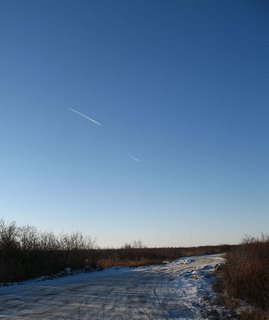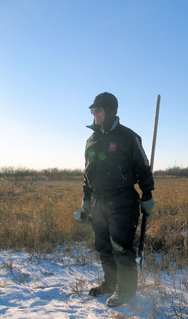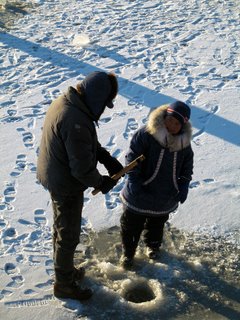Checking the Ice

The thermometer has hovered around +10 degrees for two days now, with occasional dips to near zero in some spots. Freeze up is coming along nicely. There have been occasional brief snow showers, enough to whiten things up but not enough to cushion the bumpy terrain of the tundra. From the banks, the Kuskokwim River looks quite solid, and people are venturing out carefully, walking and pulling small sleds.
Henry is getting antsy to get on the back of a dogsled and get out into the country. Traveling is still a little chancy at this time of the year, but with careful checking it can be safe. Henry asked Dutch and me to go with him for an afternoon outing to check the ice. From his dogyard he must cross Hangar Lake to get out of town, and its state of frozenness governs the start and end of his mushing season.

Bethel’s only long empty road is the road that goes out to Hangar Lake. It is perhaps a mile and a half long, and ends in a small turnaround at the edge of the lake. Hangar Lake is large enough to be a float-plane base in the summer, and thought to be about ten feet deep. It is just a large tundra pond. Long, tough marsh grasses grow at the edge, and as the lake freezes, these provide a matrix that strengthens the ice. It is often possible to travel around the edge of the lake several days before the center is safe.
 It was a beautiful afternoon to drive out to the lake. Huge blue sky without a single cloud, low sun making dramatic shadows and no wind to speak of. Since we weren’t sure how much thin ice there might be, dogs had to stay home, much to their disappointment. They know once we start dressing into serious outdoor gear, that we’re going to do something fun.
It was a beautiful afternoon to drive out to the lake. Huge blue sky without a single cloud, low sun making dramatic shadows and no wind to speak of. Since we weren’t sure how much thin ice there might be, dogs had to stay home, much to their disappointment. They know once we start dressing into serious outdoor gear, that we’re going to do something fun.No one else was out on the lake. The ice looked great. There was already a snowmachine trail showing in the snow that headed straight across the lake. When we hiked around the edge we found no thin ice or problem spots. Henry had his long-handled ice chisel and chipped a few small holes here and there to be sure. Often vertical fractures appear in very clear ice, and these give the perspective needed to guess at the ice’s thickness. We could easily see five inches of thickness in some of the fractures. Probably strong enough to drive a car on, though nobody will for a while yet. I was really wishing we had the dogs with us. The Big Dog loves to run.
 After an hour of hiking, we sat on the tailgate of the truck and drank coffee from the thermos. It was so beautiful out there, peaceful, and very quiet. With no wind and the sun shinning on us, it felt almost balmy.
After an hour of hiking, we sat on the tailgate of the truck and drank coffee from the thermos. It was so beautiful out there, peaceful, and very quiet. With no wind and the sun shinning on us, it felt almost balmy.Henry told us a funny story. Henry is a long-time friend of an outstanding Yupik musher from one of the upriver villages, Mike Williams. Mike is a veteran of over a dozen Iditarods, and skillfully manages the diet and training of his large dogyard. His son, Mike Jr., is an up-and-coming young musher in the mid-distance races.
Mike recently arranged for an Inupiat musher in Barrow to send him a thousand pounds of whale blubber to use for dog food. It arrived by cargo plane, frozen into one solid 4’ x 4’ x 4’ lump. A fork lift was used to load it into Mike’s truck. After that, it was his problem.
 Henry agreed to help Mike out. They decided to put about 300 pounds of whale into Henry’s big freezer; Mike wanted to take the rest home to his dog team by boat (this was late September). After 3 days sitting in the back of Mike’s truck, the edges of the block softened enough that the outer strips of blubber could be peeled off. Each one was about four feet long, a foot wide and nearly a foot thick, and weighed thirty or forty pounds. They used crow bars and boat oars to pry the strips apart.
Henry agreed to help Mike out. They decided to put about 300 pounds of whale into Henry’s big freezer; Mike wanted to take the rest home to his dog team by boat (this was late September). After 3 days sitting in the back of Mike’s truck, the edges of the block softened enough that the outer strips of blubber could be peeled off. Each one was about four feet long, a foot wide and nearly a foot thick, and weighed thirty or forty pounds. They used crow bars and boat oars to pry the strips apart..

.
The biggest problem was holding on to them. Blubber is pure fat; they were slipperier ‘n goose snot as my hillbilly kin might say. Grease from the warming blubber got on everything, including both men as they tried to carry and stack the big strips.
When they couldn’t manage to peel any more strips off, Mike drove his truck to the small boat harbor where his skiff was moored. The cube of thawing blubber now weighed about 700 pounds, and the two had to load it from the back of the truck into the boat. Henry was afraid of putting a hole in the boat if they just shoved the cube off the truck and let it fall.

They decided to try to lower it gently, but between the grease on the surface of the cube and all over both guys, it somehow didn’t work. Just as the cube came down, the boat (which wasn’t moored to the truck) danced sideways and splash! Seven hundred pounds of whale blubber are now sitting in three feet of water. Floating, actually. Thawing would now commence at a much faster speed. The cube was quickly surrounded with a thick grease slick.
They managed to drag the cube out of the water and pry it apart into hunks small enough to pick up and heave into the boat, and Mike took off to get it home to his dogs. I hope they like it; he says “it lets them run really fast.”

Driving home from Hangar Lake, Dutch and I drove past the waterfront and stopped to watch people out ice fishing. It is called manaqing. First a hole is chipped or augured into the ice about a foot across. A short 18” stick is used as the fishing pole with very stout line attached to it. A large hook is on the end of the line. The hook is baited and lowered through the hole in the ice; the fisherman sits or stands at the edge of the hole and bobs the pole until something strikes. Then s/he rolls the pole, wrapping line around the end until the fish is brought up.
The target fish right now is lush, a bottom-feeding cod relation. Some people say the meat tastes like lobster. A delectable Yupik dish is fried lush livers. The liver is actually a fairly large organ in this fish, two to three inches long and an inch thick. Fried quickly in hot oil with a breadcrumb coating, they are quite delicious. They don’t taste like liver at all (this from an avowed liver-hater); they taste like a fish pate with a crust.

An afternoon of ice fishing is often a family affair. Several adults and a few kids will drag a small sled with tools and supplies out to a spot on the ice and chip four or five different holes so that each one fishing has his or her own hole. A dozen lush would be a good catch for a family. Today had perfect weather for ice fishing; I hope all the folks out there caught some.
Photos by The Tundra PA. The road to Hangar Lake. One edge of Hangar Lake. Henry. Float plane launching ramp at Hangar Lake. Kuskokwim River in front of Bethel. Families ice fishing. More ice fishing. Dad shows daughter how to hold manaqing stick. Two kids fishing, Dad at the sled.
Labels: Life in Bethel




6 Comments:
Hello TMD,
So nice to find your site. I have been enjoying your posts, pics and all that is Alaska. I am a newcomer to AK and also a mid-level living in the Mat-Su valley. I dreamed of taking a position like yours, but didnt think my family would be able deal with the isolation. Many thanks for letting me live vicariously through your blog.
You sure make Alaska sound like heaven! Maybe it is.
How beautiful everything looks with the light snow covering and very blue sky. I wish the snow would be here now in southern Ontario rather than grey skies and drizzle. It won't be long though until you are in much more daytime darkness. I have never experienced that.
I was out there fishing and checking the ice with you. Great evocative description.
Thank you for sharing your pictures of Alaska. I enjoy coming to your blog and reading your posts.
MJ
Thanks, all of you, for visiting and for commenting. I love comments, especially such generous ones.
lisabeth--welcome to Alaska! After you make it through your first winter here, you get bragging rights! If you'd like a little frontier experience, perhaps you should consider doing a locums out here with us. We could sure use the help. Glad you enjoy the blog!
anon--Alaska is not for everybody, but for some of us it is heaven!
ruth--I hope your whitening comes soon! I love snow-covered vistas. The dark here isn't that bad in the winter. We'll have about 4 hours of daylight on the winter solstice. If you get out most days around noon and get ten or fifteen minutes of sunshine on your face and hands, it helps a lot. I've never had a problem with Seasonal Affective Disorder (SAD). I want to go up to Barrow in the winter and experience full 24-hour darkness. (don't want to live there, you understand...)
borneo breezes--*thanks!* it was one of those great afternoons.
motherJ--really glad you like it--come back often! (my sitemeter needs all the help it can get.)
Post a Comment
<< Home